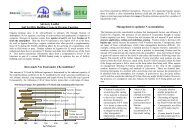Green Manures booklet - Institute of Organic Training and Advice
Green Manures booklet - Institute of Organic Training and Advice
Green Manures booklet - Institute of Organic Training and Advice
You also want an ePaper? Increase the reach of your titles
YUMPU automatically turns print PDFs into web optimized ePapers that Google loves.
Mustard (Sinapis alba)<br />
The use <strong>of</strong> green manures<br />
Suitability:<br />
SG, WG<br />
pH range preferred:<br />
5.3-6.8<br />
Height:<br />
30-60 cm<br />
Frost tolerance:<br />
Poor<br />
This is one <strong>of</strong> the most widely grown green manures,<br />
largely as a result <strong>of</strong> the cheapness <strong>of</strong> the seed. It grows<br />
large very quickly but it is very shallow rooted. It is not<br />
completely frost hardy but survives in some winters. Frost<br />
kill need not be a disaster for a winter green manure,<br />
providing that it occurs late in the season <strong>and</strong> there has<br />
been time for significant nitrogen conservation to have<br />
occurred. Much interest has been shown in caliente type<br />
varieties recently. These have been bred for their high<br />
glucosinilate content that under the right conditions can<br />
have biocidal properties against pests, weeds <strong>and</strong> diseases.<br />
These properties are discussed in more detail under<br />
section 4.5.<br />
Stubble turnips, Oil seed rape, Fodder radish. (Brassica rapa, Brassica napus, Raphanus sativus) The main<br />
role <strong>of</strong> these crops is as a source <strong>of</strong> winter grazing (usually for sheep) with green manuring effects after<br />
incorporation <strong>of</strong> secondary importance.<br />
OTHER NON LEGUMES<br />
A number <strong>of</strong> other species may be suitable (even sunflowers have been suggested) but three in particular, quite<br />
unrelated to other agricultural plants, are usually thought <strong>of</strong> as green manures.<br />
Phacelia (Phacelia tanacetifolia)<br />
Suitability:<br />
SG, WG<br />
pH range preferred:<br />
No specific<br />
requirements<br />
Height:<br />
30-60 cm<br />
Frost tolerance:<br />
Poor<br />
Buckwheat (Fagopyrum esculentum)<br />
Suitability:<br />
SG<br />
pH range preferred:<br />
5.0-7.0<br />
Height:<br />
40-60 cm<br />
Frost tolerance:<br />
Poor<br />
This grows rapidly from either winter or spring sowings.<br />
Although not completely frost hardy it will survive in mild<br />
winters. It produces striking blue flowers <strong>and</strong> is<br />
sometimes planted solely to attract beneficial insects but<br />
by this stage the plants will have become very stemmy <strong>and</strong><br />
slow to decompose. It also has a strong tendency to<br />
become a weed in subsequent crops.<br />
This is a broad leaved summer annual that requires only a<br />
short growing season (2-3 months). It may self seed to<br />
produce a second crop – this may cause a weed problem.<br />
It will tolerate infertile soils but performs badly on heavy<br />
soils. It is believed to be effective at scavenging the soil<br />
for phosphorus. The crop may be grown as an attractant<br />
for beneficial insects<br />
12




